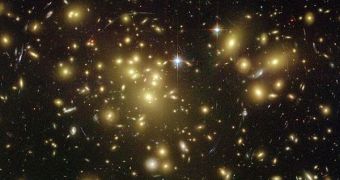Discovering dark matter is undoubtedly among the most important goals in science today. This elusive form of matter is thought to be responsible for holding galaxies in place through the gravitational effects it exerts on regular matter. However, no team in the world has until now been able to catch a glimpse at the particles that make up the stuff, although many have tried. Among the groups at the forefront of dark matter research is the team managing the Cryogenic Dark Matter Search experiment (CDMS). This is one of the top 3-rated studies on this issue in the world.
The group of experts operating the dark matter detectors, currently located deep underground in the Soudan Mine of Minnesota, is looking for weakly-interacting massive particles, also called WIMP, which are believed to be the main components of this form of matter. According to theoretical models, these elementary particles should exist in the 1 to 200 gigaelectronvolts (GeV) range, which means that they should be 1 to 200 times the mass of individual protons. However, discovering these WIMP has proven to be beyond reach until now. No group in the world, regardless of the way they went about finding them, managed to produce uncontroversial evidence of their existence.
“It's kind of trying to find a needle in a haystack. But we tend to do things a little differently in science. Instead of just digging for the needle, we are looking at getting rid of some of the hay,” explains Wolfgang Rau, a particle astrophysics professor at the Queen's University of Kingston, in Canada. The expert is also the holder of a Canada Research Chair position in particle astrophysics. He is the sole Canadian researcher on the CDMS group, which features scientists from around the world. Rau explains that the proverbial “needle” in this instance translates into discovering interactions between dark matter and normal matter particles.
Conversely, the haystack is represented by a vast number of interactions that occur between particles in normal matter and elements coming in from other sources, including cosmic radiation and so on. The expert says that two experiments at the CDMS, which are covered in a paper published in a recent issue of the esteemed journal Science, have some of the characteristics associated with interactions between dark and normal matter.
“We do additional tests to see if these interactions have come from background sources or if they were indeed from dark matter particles. We have seen these two events and so far we really can't say what it is. We have reached the limit of what our experiment can do with this configuration. Presently we are upgrading our detectors to improve our sensitivity, but eventually we plan to build a much bigger experiment at SNOLAB, the [Queen's affiliated] underground laboratory near Sudbury,” Rau adds. “Dark matter makes up roughly 85 per cent of the matter in the universe and we don't know what it is. Dark matter is responsible for us having galaxies in the first place and plays a very important role in the evolution of the universe. It is fundamental science what we are doing. If there was no dark matter, we wouldn't be here,” he concludes.

 14 DAY TRIAL //
14 DAY TRIAL //